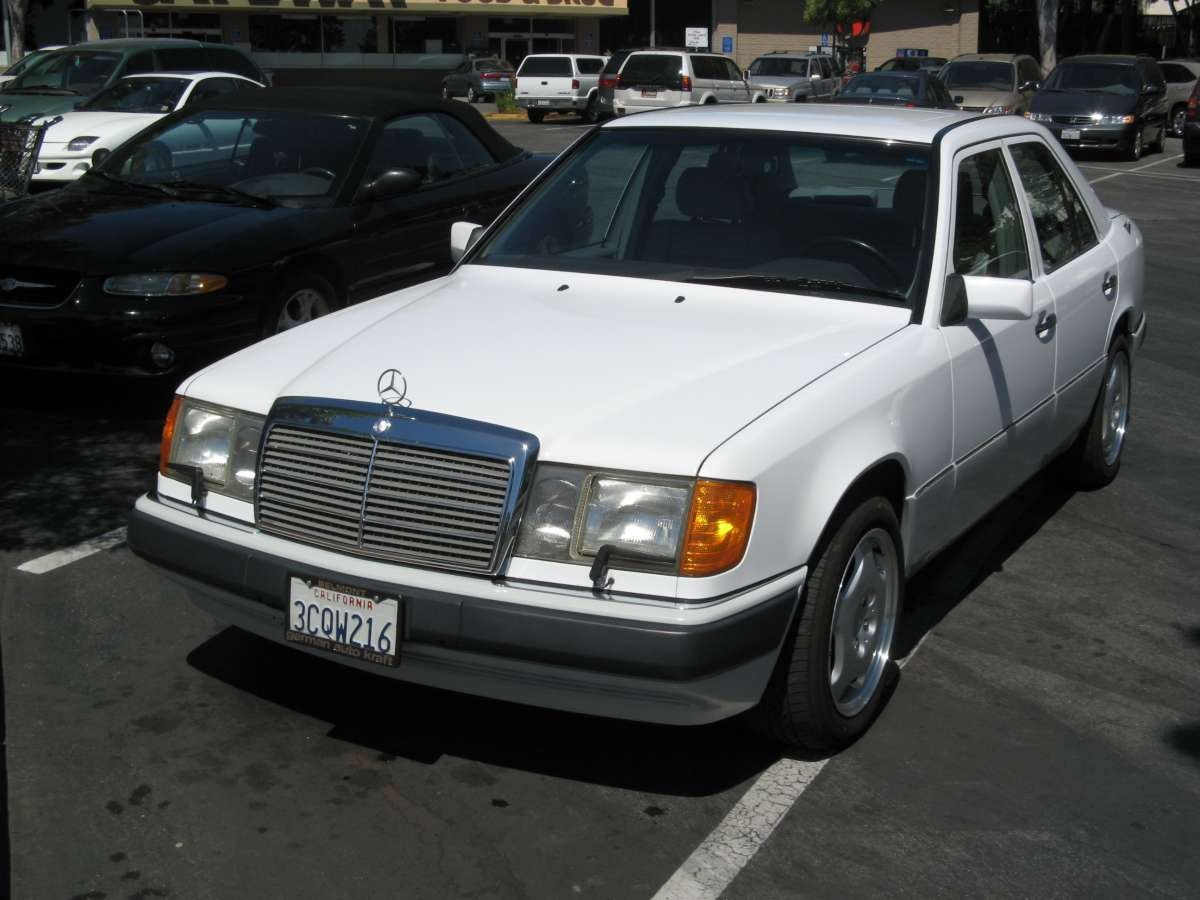For enthusiasts in the know, the allure of an understated performance car is undeniable. It’s about enjoying potent capabilities without shouting about them, a philosophy embodied perfectly by models like the Audi S4, Saab 9-2X, and Buick Regal GS. Following this lineage of subtle yet powerful machines, the Mercedes-Benz 400E emerges as a true gem. Let’s delve into why this V8-powered sedan deserves recognition as an understated classic.
I’ve long held a deep appreciation for the Mercedes-Benz W124 chassis, a fascination that began in my high school years back in 1985 when I first encountered the 300E. Its design was a harmonious blend of classic elegance and modern sensibilities, clearly drawing inspiration from the 190 while forging its own path. Built to the uncompromising standards that once defined Mercedes-Benz, the W124 in the US market initially offered robust 6-cylinder engines and, for a period, the option of a diesel powerplant.
In 1992, Mercedes-Benz expanded the W124 range, introducing two notable V8 models. While the spotlight often fell on the high-performance 500E, a collaboration with Porsche featuring a 5-liter V8 and widened body, its sibling, the 400E, offered a more discreet approach to V8 power. The 500E, with its $82,150 price tag (including gas guzzler tax in 1992), was undeniably exclusive. However, the 400E presented an intriguing alternative. For a base price of $60,175 in 1992, buyers could experience V8 performance in a package visually indistinguishable from the 300E. Over the subsequent four years, 15,425 discerning buyers in the US opted for this blend of stealth and power.
Recently, while browsing Craigslist, I stumbled upon a 400E advertised by San Francisco Toyota. The asking price was $9200, and remarkably, the odometer read only 32,000 miles. Initially skeptical of a typo, a phone call confirmed the mileage. A CarFax report further validated the car’s history: a single owner from Belmont, my workplace at the time, with consistent servicing at Autobahn Mercedes in Belmont. This was an opportunity I couldn’t ignore.
The following day, I drove to San Francisco to inspect the 400E. It lived up to its online description – essentially brand new. Finished in white with a gray interior, the paint was immaculate, the interior flawless, and the chrome trim gleamed. There were no discernible signs of wear, with the only minor omission being the floor mats, though the underlying carpets were pristine. Everything functioned as expected, and the car drove beautifully. While I attempted to negotiate a lower price, the dealership remained firm. Ultimately, securing a slight reduction became secondary to the rarity of finding a 400E in such exceptional condition, especially considering I had received a favorable price for my previous Buick.
There’s an undeniable sense of occasion when you settle behind the wheel of a Mercedes-Benz, gazing down the hood towards the iconic three-pointed star. The 400E exuded a special aura, feeling substantial and robust, akin to being hewn from a solid block of metal. The doors closed with a reassuring “thunk,” devoid of any lingering vibrations. Slamming the door resulted in a definitive, solid closure.
So, what exactly is a 400E, and what sets it apart? Externally, as mentioned, it mirrors the 300E, save for the model badging and a different wheel design. Inside, however, the 400E elevated the experience with standard leather upholstery (replacing the still-excellent MB-Tex), burl walnut wood trim instead of Zebrano (though personally, I find the Zebrano more appealing in its “realness”), automatic climate control, dual airbags, and other premium features.
Under the hood resided a 4.2-liter 32-valve V8 engine, producing a healthy 268 horsepower at 5700 rpm and 295 lb-ft of torque at 3900 rpm. Paired with a 4-speed automatic transmission featuring the signature Mercedes-Benz gated shifter, the 400E delivered brisk performance. With a weight just over 3800 lbs, it was genuinely quick for its era. Surprisingly, it also felt remarkably agile. Once accustomed to the transmission’s slight hesitation to downshift, you could confidently exploit gaps in traffic. However, the 400E’s true party piece was its exhilarating freeway acceleration.
The San Francisco Peninsula boasts several lengthy freeway on-ramps, some extending over a mile, which I frequently used. Merging onto these on-ramps, pressing the accelerator unleashed a glorious V8 howl as the engine revved towards its 6000 rpm redline, shifting up and repeating the surge of power. The acceleration felt relentless. Once on the freeway, passing power was abundant. Even at 80 mph, a touch of the throttle would push you back into your seat, rapidly escalating speed well beyond legal limits, yet the car continued to pull with undiminished vigor.
Car and Driver, in their April 1992 issue, aptly described the 400E as the 500E’s “little brother” but suggested it was nearly its equal in many respects. They noted that unless you had driven the 500E, you wouldn’t miss the marginal power difference, and the significant $27,000 price saving would easily offset any perceived deficit. While acknowledging the 500E’s special status and desirability, they concluded that the 400E was a “true gem” in its own right.
Years prior to my purchase, I recall encountering a 400E at an auction, admiring its pristine condition. It was only upon settling into the driver’s seat that I noticed the odometer reading exceeded 200,000 miles. This solidified my understanding that these cars were engineered for longevity and, with diligent maintenance, could endure almost indefinitely.
Regarding maintenance and repairs, the 400E proved to be relatively straightforward. High-quality German OEM parts were readily and affordably available from numerous online sources. On one occasion, a noticeable power loss led me to diagnose a cracked distributor cap. Ordering replacements for both distributors, along with new spark plugs and leads (given their likely age), resolved the issue. The distributors, while positioned somewhat awkwardly at the front of the engine, were easily accessible for replacement.
In another incident, a piece of road debris, likely a metal bar or wrench, struck the passenger side mirror on the freeway, shattering the mirror housing and glass. Fortunately, eBay provided a color-matched replacement mirror at a reasonable price, which I installed myself.
Replacing the missing floor mats with genuine factory items and obtaining a spare key were also surprisingly affordable, considering the 400E’s original price point.
I also opted to replace the factory 15-inch wheels and tires with 16-inch pseudo-AMG wheels from a later E-Class model. At the time, I appreciated the updated look. However, in retrospect, I might have either retained the original wheels, which possess their own classic appeal, or gone all-in with authentic, thick-spoke AMG alloys and subtly lowered the ride height. The accompanying images illustrate both wheel styles for comparison.
The early 1990s marked a transitional period for the E-Class. 1992 saw the introduction of lower side cladding, while the core body structure remained consistent. The 1994 facelift brought subtle changes, including a body-colored grille surround, smoked taillight lenses, and a renaming of models: the 300E became the E320, the 400E became the E420, and the 500E became the E500, with no mechanical changes to the V8 variants.
The 400E’s interior was a delightful space. The seats, constructed with traditional springs rather than modern foam, offered a distinct and substantial feel. Quirky features abounded, such as the dashboard button that pneumatically dropped the rear headrests for improved rear visibility – raising them, however, required manual effort. The passenger-side mirror was power-operated, while the driver’s side remained manually adjustable – a charming anachronism in a car of this caliber.
The climate control system, utilizing Mercedes-Benz’s signature thumbwheels, was another highlight. In “auto” mode, adjusting the temperature setting intuitively controlled fan speed, a far more user-friendly system than the button-laden interfaces common in contemporary cars. It remains my preferred “automatic” climate control system, as I generally favor manual controls over overly complex automatic systems.
Mercedes-Benz also maintained a commitment to eliminating blank option buttons. Regardless of the chosen options, the center console panel was tailored to reflect the car’s specific equipment, avoiding unsightly blank spaces – a testament to their attention to detail, albeit likely a costly approach.
When I acquired the 400E in 2005, I was commuting 42 miles each way to Lafayette. Within a year, a move to Belmont shortened my commute to a mere two miles. While the short drives prevented the engine from fully warming up, they also revealed the V8’s thirst for fuel, averaging around 11 mpg in town, improving to the high teens or low twenties on the highway. Despite high gas prices at the time, my reduced commuting distance mitigated the impact.
However, the 400E’s surprisingly snug rear seat, coupled with the impending arrival of our second child and the challenges of fitting a rear-facing car seat, prompted a change. Despite my deep appreciation for the car, the time had come to move on.
I sold the 400E to an enthusiast who had previously owned and regretted selling one. With approximately 70,000 miles on the odometer, it sold for $7,700, representing one of my better automotive transactions. The new owner, mirroring my own sentiments, recognized the exceptional condition and readily purchased it. The 400E left a lasting impression – a testament to a bygone era of Mercedes-Benz engineering. They simply don’t build them like they used to, at least not at Mercedes-Benz.

